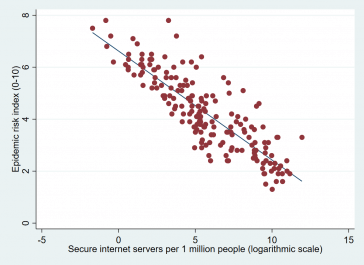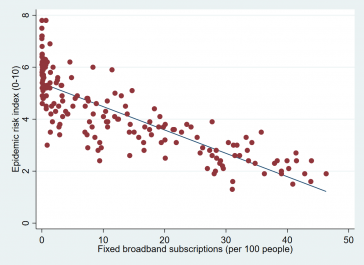2020 was a year like no other. The world suddenly came to a standstill and most of us, with just the exception of frontline workers, were stuck in our homes. And in those trying times technology has emerged as a savior for a majority of us.
People have been able to remotely work their jobs with the help of technology, we have been able to shop for essentials online using technology, we have been able to keep ourselves engaged and entertained, again with the use of technology.
A World Bank report even suggested that countries with secure Internet servers and wider Internet access are in a better position to mitigate the risk of the pandemic.


As the images above show, safe servers and better Internet access positively correlate with a lower risk of the epidemic spread.
Also, several entrepreneurs and governments have used technology to battle the COVID-19 pandemic.
Several efforts have been taken to alleviate the crisis of COVID-19 in various ways using modern technology including developing products/digital offerings, predicting and tracking the spread of the virus, as well as enhancing efficiency, reach, and protection from cyber-attacks for medical organizations.
Some of the remarkable steps taken from all over the world using technology are discussed below –
Big Data helps understand the genetic tree of the virus – Understanding how the coronavirus behaves is very relevant so that measures can be taken to stop its spread. An open-source project called “Nextstrain” provides data, visualizations, and sequencing which shows the evolution of coronavirus. It also provides information to the epidemiologists which helps in understanding the possible mutations which can change its nature. In the wake of new strains emerging at a rapid speed, the use of Big Data can help medical professionals and scientists better prevent and predict the spread.
Providing network help to a floating hospital – A passenger ferry has been converted into a floating hospital to help overcome the pandemic of COVID-19. A Hewlett Packard Company has installed network infrastructure on that ferry which includes 4 kilometers of cable and 70 access points which provides Wi-Fi coverage for patients and healthcare workers on board.
Get information about COVID-19 testing sites – Postman, a platform for API development, has created a website that depends on crowd-sourced information to locate the sites of coronavirus testing in the US. Also, the API resource center gives a list of APIs for government experts, researchers, and health care workers who need access to real-time critical data quickly. A similar platform has been developed and deployed by the Government of India. The portal called COWIN lets citizens book their vaccination slots in time.
WHO Chatbot providing 24×7 Healthcare support – The World Health Organization (WHO) has launched a chatbot to dispense information regarding the coronavirus. It gives answers to all the frequently asked questions about the virus, its manifestation, the current infection rates, and protective measures that can be taken. To have a greater impact and reach, the WHO chatbot operates on the WhatsApp platform acting as an official source of information.
Managing remote workplace through video calls – The popular applications used for video calls are Google hangouts, Duo, Skype, zoom, and many more. The download figures for these applications have increased tremendously since the beginning of the pandemic. These tools and applications have become unavoidable and are being used to conduct meetings for the team or staying in touch with a loved one.
3D printers are playing a crucial role – The most essential equipment for the treatment of coronavirus is a ventilator and the health system is facing a shortage of supplies for the same. To address this issue, IT geniuses around the world created a network through which they can share the open-source design for manufacturing ventilators with the help of 3D printers.
Stay updated with COVID-19 global tracker – The analytics firm Domo provides a global tracker for COVID-19 which is updated every 10 minutes. The tracker collects and verifies the data from sources like World Health Organization (WHO), Worldometer, Centre for Disease Control (CDC), Enigma, and Johns Hopkins University.
Self-diagnosis platforms – There are various applications to fight the pandemic and combat stress all over the world. A suspected individual can conduct a self-assessment based on their symptoms and the application will provide the advice and instructions for the steps that should be taken. The Chinese government along with application development companies came up with a color-coded health rating system through an application (QR Code) that tracks millions of people daily. It assigns one of the three colors to the people based on their medical and travel histories. Based on the color code only it is decided whether a person was supposed to be in quarantine or is allowed in public places.
Robots and drones minimizing the risk of transmission – Robots and drones are active in the medical battleground now working to prevent the transmission of coronavirus. As per a report, robots are used to serve food and other things to the people who are quarantined. In the severely affected areas, drones carry the medical equipment and patient samples, and some of them are also used to broadcast the warning to the people to not step out from the home and wear face masks. All these steps are taken to prevent the spread of the deadly coronavirus.
Artificial Intelligence and Machine Learning are becoming the backbone of Healthcare – Medical professionals can understand more about the disease through data analytics and predictive models and so we can say that artificial intelligence is playing an important role in health care these days. A biotechnology company is using a model based on machine learning which can develop therapies based on antibodies from patients who have already recovered from the disease.
Self-driving vehicles delivering essentials – Self-driving vehicles prove to be of immense utility currently, in delivering essential goods like foodstuffs and medicines. These kinds of vehicles became part of the mission also by operating as street cleaning vehicles and disinfecting hospitals.
To Wrap Up
It isn’t an overstatement to say that the COVID-19 pandemic has changed the world as we know it. However, technology has acted as a reliable resource for the world.
What we discussed was a glimpse of the contribution of technology towards battling the COVID-19 pandemic.
Know about other groundbreaking technology initiatives that are making us stronger in our fight against the virus? Let us know in the comments section below and spread the word.
Need a job? You can find a job on Jooble.
Have a tech-backed idea that you think can bolster our stand against COVID? Time to get the ideas implemented. Contact us at contact@synergytop.com to discuss your project and get it developed at the earliest.

SynergyTop extends a heartfelt thank you to the real rockstars and unsung heroes at this time of turmoil and crisis. Doctors, nurses, police personnel, and other frontline workers are working beyond their capacity and it is impossible to put their efforts into words. They are sacrificing their health and working day and night so that we can stay healthy. Their selflessness and wholeheartedness deserve a salute.
















